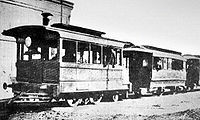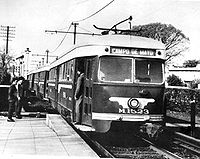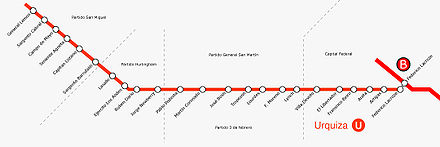
Línea Urquiza (Buenos Aires)
Encyclopedia
The Urquiza Line is a 25.5 km (16 mi) suburban electric commuter line operated by the subway operator Metrovías
, in Buenos Aires
, Argentina
. It runs from the Federico Lacroze terminus in the barrio
of Chacarita, to General Lemos terminus, Campo de Mayo in Greater Buenos Aires
, a total journey time of 46 min. The line uses third rail current collection and, at present, is used by an average of 75,400 passengers daily and operates 20 hours a day, 7 days a week at 8 to 30 minute intervals. This suburban line runs on track once operated by Ferrocarril General Urquiza
before railway privatisation
.
In earlier times the line was planned to run into the centre of Buenos Aires, through a long tunnel. But when the tunnel was finally built in 1930, it was taken over by the subway
system, so that suburban passengers had to change at Federico Lacroze, named after its builder, about 6 km (3.7 mi) from the centre. Today Federico Lacroze has a direct connection to the line B subway station of the same name.
Like the Buenos Aires Metro
system, the Urquiza line uses the standard
1,435 mm (4 ft 8 ½ in) gauge
rather than the gauge
used in other interurban railways of Buenos Aires.

 The brothers Federico and Teófilo Lacroze were pioneers opening several horse-drawn tramway lines in Buenos Aires city, first in 1868 from Plaza de Mayo
The brothers Federico and Teófilo Lacroze were pioneers opening several horse-drawn tramway lines in Buenos Aires city, first in 1868 from Plaza de Mayo
to Plaza Once and in 1870 the "Tramway Central of Lacroze".
On 2 October 1884, they were granted a concession to build a 47 kilometres (29.2 mi) railway also pulled by horses from Buenos Aires through open country southwest to Pilar
. On 6 April 1888, the line was opened with the name of "Tramway Rural", (rural tramway) to Pilar with a branch to San Martín thereafter.
Three years later, in 1891, it was converted to steam and as the capital expanded, business to the suburbs was so good that a new branch to Campo de Mayo was inaugurated in 1904 using electric power supply, and the whole section between Federico Lacroze and San Martín was electrified in 1908. Electricity came from the Lacroze tramways of Buenos Aires and overhead wires delivered 600 volt DC current to a fleet of wooden US-style interurban coaches from Brill.
In 1897 the line was renamed Ferrocarril Rural de la Provincia de Buenos Aires and in 1906 it was renamed again to Ferrocarril Central de Buenos Aires
. However, since it was still operated by its owners, it continued to be known unofficially as the "Federico Lacroze Rural Tramway".
The original cars were still running by the end of the 1940s and had become too unsafe to permit continued private operation, and the line was nationalised
by the Peronist government in 1948 and became part of Ferrocarril General Urquiza
, one of the several divisions of the state-owned Ferrocarriles Argentinos
.
By 1951 it was completely rebuilt, new substations were set up, new modern cantilever roofed stations of reinforced concrete were built and 28 used 1700 series interurban coaches, manufactured by Pacific Electric Railway
between 1925 and 1928, were bought . These were used until the early 1970s when they were replaced by 128 new Japanese subway coaches, third rail current collectors were installed and the station platforms were raised at the same time to match the new coaches.
One interesting fact is that in 1959, Ferrocarril General Urquiza acquired 30 PCC coaches
, built by the St. Louis Car Company
in 1940. These were modified at the ends to operate in two, three or four-sectioned articulated formations like most modern LRVs. They were all retired by the mid-1960s, because they were too lightly built to handle the heavy passenger loads.
are not compatible with each other and therefore do not agree on it.

Metrovías
Metrovías S.A. is a privately owned company which, on 1 January 1994, took over the concession, granted by the Argentine government as part of railway privatisation during the presidency of Carlos Menem, for the operation of the standard gauge Urquiza Line commuter rail service in Buenos Aires,...
, in Buenos Aires
Buenos Aires
Buenos Aires is the capital and largest city of Argentina, and the second-largest metropolitan area in South America, after São Paulo. It is located on the western shore of the estuary of the Río de la Plata, on the southeastern coast of the South American continent...
, Argentina
Argentina
Argentina , officially the Argentine Republic , is the second largest country in South America by land area, after Brazil. It is constituted as a federation of 23 provinces and an autonomous city, Buenos Aires...
. It runs from the Federico Lacroze terminus in the barrio
Barrio
Barrio is a Spanish word meaning district or neighborhood.-Usage:In its formal usage in English, barrios are generally considered cohesive places, sharing, for example, a church and traditions such as feast days...
of Chacarita, to General Lemos terminus, Campo de Mayo in Greater Buenos Aires
Greater Buenos Aires
Greater Buenos Aires is the generic denomination to refer to the megalopolis comprising the autonomous city of Buenos Aires and the conurbation around it, over the province of Buenos Aires—namely the adjacent 24 partidos or municipalities—which nonetheless do not constitute a single administrative...
, a total journey time of 46 min. The line uses third rail current collection and, at present, is used by an average of 75,400 passengers daily and operates 20 hours a day, 7 days a week at 8 to 30 minute intervals. This suburban line runs on track once operated by Ferrocarril General Urquiza
Ferrocarril General Urquiza
Ferrocarril General Urquiza , named after the Argentine general and politician Justo José de Urquiza, was one of the six state-owned Argentine railway companies formed after President Juan Perón's nationalisation of the railway network in 1948...
before railway privatisation
Railway Privatisation in Argentina
Following a prolonged period of hyperinflation in the 1980s, accompanied by a steep increase in fiscal deficit and a sharp fall in reserves, the Argentine government, under the presidency of Carlos Menem from 1989, initiated a series of neoliberal reforms which included the privatisation of...
.
In earlier times the line was planned to run into the centre of Buenos Aires, through a long tunnel. But when the tunnel was finally built in 1930, it was taken over by the subway
Buenos Aires Metro
The Buenos Aires Metro , locally known as Subte is a mass-transit system that serves the city of Buenos Aires, Argentina. The first station of this network opened in 1913, the first of its kind in South America, the Southern Hemisphere and the entire Spanish-speaking world...
system, so that suburban passengers had to change at Federico Lacroze, named after its builder, about 6 km (3.7 mi) from the centre. Today Federico Lacroze has a direct connection to the line B subway station of the same name.
Like the Buenos Aires Metro
Buenos Aires Metro
The Buenos Aires Metro , locally known as Subte is a mass-transit system that serves the city of Buenos Aires, Argentina. The first station of this network opened in 1913, the first of its kind in South America, the Southern Hemisphere and the entire Spanish-speaking world...
system, the Urquiza line uses the standard
Standard gauge
The standard gauge is a widely-used track gauge . Approximately 60% of the world's existing railway lines are built to this gauge...
1,435 mm (4 ft 8 ½ in) gauge
Rail gauge
Track gauge or rail gauge is the distance between the inner sides of the heads of the two load bearing rails that make up a single railway line. Sixty percent of the world's railways use a standard gauge of . Wider gauges are called broad gauge; smaller gauges, narrow gauge. Break-of-gauge refers...
rather than the gauge
Broad gauge
Broad-gauge railways use a track gauge greater than the standard gauge of .- List :For list see: List of broad gauges, by gauge and country- History :...
used in other interurban railways of Buenos Aires.
History


Plaza de Mayo
The Plaza de Mayo is the main square in downtown Buenos Aires, Argentina. It is flanked by Hipólito Yrigoyen, Balcarce, Rivadavia and Bolívar streets....
to Plaza Once and in 1870 the "Tramway Central of Lacroze".
On 2 October 1884, they were granted a concession to build a 47 kilometres (29.2 mi) railway also pulled by horses from Buenos Aires through open country southwest to Pilar
Pilar, Buenos Aires
Pilar is a city in the province of Buenos Aires, Argentina. It has a population of more than 226,000 inhabitants as per the . Pilar is part of the Greater Buenos Aires urban conurbation and is the head of the administrative division of Pilar Partido...
. On 6 April 1888, the line was opened with the name of "Tramway Rural", (rural tramway) to Pilar with a branch to San Martín thereafter.
Three years later, in 1891, it was converted to steam and as the capital expanded, business to the suburbs was so good that a new branch to Campo de Mayo was inaugurated in 1904 using electric power supply, and the whole section between Federico Lacroze and San Martín was electrified in 1908. Electricity came from the Lacroze tramways of Buenos Aires and overhead wires delivered 600 volt DC current to a fleet of wooden US-style interurban coaches from Brill.
In 1897 the line was renamed Ferrocarril Rural de la Provincia de Buenos Aires and in 1906 it was renamed again to Ferrocarril Central de Buenos Aires
Ferrocarril Central de Buenos Aires
The Ferrocarril Central Buenos Aires was a railway company in the Buenos Aires Province of Argentina, which built and operated a railway line from Buenos Aires to 4 de Febrero....
. However, since it was still operated by its owners, it continued to be known unofficially as the "Federico Lacroze Rural Tramway".
The original cars were still running by the end of the 1940s and had become too unsafe to permit continued private operation, and the line was nationalised
Railway Nationalisation in Argentina
In 1948, during President Juan Perón’s first term of office, the seven British-owned and three French-owned railway companies then operating in Argentina, were purchased by the state...
by the Peronist government in 1948 and became part of Ferrocarril General Urquiza
Ferrocarril General Urquiza
Ferrocarril General Urquiza , named after the Argentine general and politician Justo José de Urquiza, was one of the six state-owned Argentine railway companies formed after President Juan Perón's nationalisation of the railway network in 1948...
, one of the several divisions of the state-owned Ferrocarriles Argentinos
Ferrocarriles Argentinos
Ferrocarriles Argentinos was a public company that managed the entire Argentine railway system for nearly 45 years. It was formed in 1948 when all the private railway companies were nationalised during Perón's first presidential term, and transformed into the Empresa de Ferrocarriles del Estado...
.
By 1951 it was completely rebuilt, new substations were set up, new modern cantilever roofed stations of reinforced concrete were built and 28 used 1700 series interurban coaches, manufactured by Pacific Electric Railway
Pacific Electric Railway
The Pacific Electric Railway , also known as the Red Car system, was a mass transit system in Southern California using streetcars, light rail, and buses...
between 1925 and 1928, were bought . These were used until the early 1970s when they were replaced by 128 new Japanese subway coaches, third rail current collectors were installed and the station platforms were raised at the same time to match the new coaches.
One interesting fact is that in 1959, Ferrocarril General Urquiza acquired 30 PCC coaches
PCC streetcar
The PCC streetcar design was first built in the United States in the 1930s. The design proved successful in its native country, and after World War II was licensed for use elsewhere in the world...
, built by the St. Louis Car Company
St. Louis Car Company
The St. Louis Car Company was a major United States manufacturer of railroad passenger cars, streetcars, trolleybuses and locomotives that existed from 1887–1973, based in St. Louis, Missouri.-History:...
in 1940. These were modified at the ends to operate in two, three or four-sectioned articulated formations like most modern LRVs. They were all retired by the mid-1960s, because they were too lightly built to handle the heavy passenger loads.
Urquiza line today
The number of passengers carried by the Urquiza Line has increased steadily in recent years and several improvements have been made, including adapting stations for the disabled, grade crossings improvements, new concrete sleepers and welded rail joints for the entire line and up-dated electrical components. In the meantime, it is still possible that the rebuilding of the existing ramp at Federico Lacroze would allow connection to line B subway, enabling trains to run through to the centre of Buenos Aires, a dilemma which is uncertain at this moment, simply because the UTA (Unión Tranviarios Automotor, in English; Tram Drivers' Union) and Rail UnionsTrade union
A trade union, trades union or labor union is an organization of workers that have banded together to achieve common goals such as better working conditions. The trade union, through its leadership, bargains with the employer on behalf of union members and negotiates labour contracts with...
are not compatible with each other and therefore do not agree on it.

Stations
- Federico Lacroze Line B Metro
- Artigas
- Arata
- Francisco Beiró
- El Libertador
- Antonio Devoto (Villa DevotoVilla DevotoVilla Devoto is a barrio or district in the northern part of Buenos Aires, Argentina, located in the area defined by Campana, San Martín avenue, Francisco Beiró avenue, Joaquín V. González, Baigorria, Lope de Vega Avenue and General Paz Avenue...
) - Villa Lynch (Ferroclub Argentino - Argentine Railway Club)
- Fernandez Moreno
- Lourdes
- Tropezón
- José Bosh
- Martín Coronado (Ciudad JardínCiudad Jardín Lomas del PalomarCiudad Jardín Lomas del Palomar is a planned community, part of the partido Tres de Febrero in Greater Buenos Aires and located adjacent to the city of El Palomar...
) - Pablo Podestá
- Jorge Newbery (HurlinghamHurlingham, Buenos AiresHurlingham is a city in the Province of Buenos Aires, Argentina. It forms part of the Gran Buenos Aires metropolitan area and is situated 23 km west of the city centre...
) - Ruben Darío
- Ejército de Los Andes
- Lasalle
- Sargento Barrufaldi (San MiguelSan Miguel, Buenos AiresSan Miguel is situated in the northwest region of Greater Buenos Aires, 30 km from the capital . It is the head town of the San Miguel Partido. Since the early 2000s its been a part of Greater Buenos Aires. According to the 2001 census the number of inhabitants was about 157.532...
) - Capitán Lozano
- Teniente Agneta
- Campo de Mayo
- Sargento Cabral
- General Lemos
External links
- Metrovías English website
- Subterráneos de Buenos Aires (Spanish)
- Buenos Aires at UrbanRail.Net
- Ferroclub Argentino (Argentine Railway Club - Lynch Branch), (Spanish-includes image gallery)
- Urquiza line train leaving station (YouTube)

